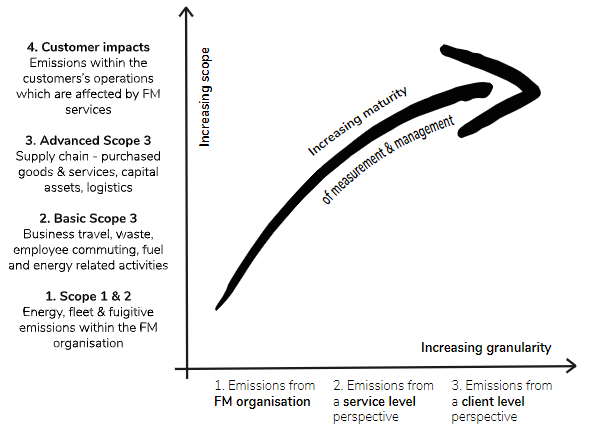This article is the first part of our article series on Scope 3 reporting in the FM industry
Within the facilities management (FM) sector, Scope 1 (direct emissions from the company’s owned or controlled sources) and Scope 2 (emissions from purchased or acquired energy) reporting is now a well-established requirement, and many FM companies have aligned their net-zero goals to Scope 1 and 2 emissions. However, for the FM sector to become truly sustainable, an understanding of its full contribution to the surrounding environment must be accomplished. To do so, it is imperative to include Scope 3 emissions within emission calculations. The graphic below highlights how, in most companies, the majority of emissions are classified as Scope 3.

The pressure for reporting maturity is growing
The FM industry has come under increasing pressure due to economic restraints, and to move forward in our net-zero focused world, there is a need to evolve. Measuring, communicating and reducing emissions, in all three Scopes, is the clearest path for the FM sector to become sustainable.
Scope 3 emissions have generally been ignored due to a fear of added responsibility or requirements to cut these emissions. Scope 3 emissions encompass those that are not directly produced by the company and are not the result of activities from assets owned or controlled by the company. In basic terms this includes business travel, waste, employee commuting, fuel and energy-related activities. At a more advanced level, this will also consider FM supply chains: purchased goods and services, capital assets and logistics. The below graph displays an emissions reporting maturity curve.

Leading net-zero transition of the supply chain
If we are to reach true net-zero goals, Scope 3 must be measured, managed and reduced. By increasing the understanding of the value chain, and in turn highlighting weak links in the supply chain, impacts on the business will be reduced. This crucial consideration will ensure a more complete version of sustainability, as the goals produced out of Scope 3 calculations will instigate greater impact; this also provides an opportunity for the FM sector to be an industry leader in sustainability.
The high-level or bottom-up approach to evaluate FM’s Scope 3
To determine these emissions, the Sustainable Facilities Management Index (SFMI) project came up with a generalised, yet robust reporting approach aimed at measuring a full Scope 1, 2 and 3 greenhouse gas (GHG) emissions inventory for an FM provider at the corporate reporting level. Our top-down approach builds a basic Scope 3 portfolio against 15 categories and can satisfy broad Scope 3 requirements, such as the Science Based Targets. There is an initial screening process, which is a high-level evaluation that identifies which categories are the most relevant to the reporting company based on materiality (material activities across the FM providers’ business and clients as a whole), ownership (owner of and/or owning the purchasing process of goods and services used), responsibility (whether the FM have responsibility for the area and can effect changes that deliver emissions reductions) and influence (whether the FM have enough influence to reduce emissions).
The bottom-up approach is a more thorough means of calculation, as it is built up from a contract level, and based on activity rather than each individual category. Here, three key factors are used to score whether activities are scoped in or out of the inventory: ownership, responsibility and influence. If all three factors have high scores they will be included. To find out more about The SFMI, please visit The SFMI site.
Other reporting angles to take into account
Aside from Scope 3 emissions, other aspects within the FM sector that are important to start measuring include climate risk, social value, and diversity and inclusion. Climate risk is escalating, and by 2050, half a million properties are expected to be classified as high risk; this has wide-ranging implications for the FM industry that must be considered, analysed and acted upon. Social value as a concept is relatively immature, however, measuring it will add financial value to the company and local area, resulting in improved relations within the community, as well as improved employee retention via social value projects, such as apprenticeships. Diversity and inclusion have advanced significantly, bringing an abundance of benefits for FM; diverse workforces demonstrate better results than non-diverse workforces, and they combine a breadth of opinions and perspectives together which result in improved decision making, increased awareness of social, cultural and environmental issues, and improve customer relations, all whilst engaging the workforce.
Communicating ESG goals
Communication to FM customers regarding sustainability and ESG topics should occur. Prior to this, it is important to understand the impact that FM has and open up conversations with customers. For example, a particular service or product that is provided may be identified as a carbon hotspot, where carbon emissions are high per fiscal unit spent. These conversations will assist in identifying opportunities for services provided to be enhanced or adjusted to help lower carbon emissions, and thus reduce the impact on the FM’s emissions, as well as the customers.
The flow of information and transparency can also improve customer relationships. These adjustments can then be transferred and used in new tenders to other clients, thereby continuing total emission reductions.
As the FM sector moves increasingly towards low-carbon, it is important to consider how FMs can contribute not only to their own net-zero goals but to their customer’s goals too. The case should be made for increased costs to result in low-carbon and high-value services. By assisting the built environment to achieve their net-zero goals, via decarbonisation of services, the FM can then become an asset and not a burden.
Scope 3 Emissions in FM
Our work on Scope 3 stems from the belief that existing building carbon assessment frameworks currently ignore FM based emissions and should therefore be considered incomplete.

SFMI Scope 3 Emissions in FM Report
The Sustainable Facilities Management Index (SFMI) and BAM FM have teamed up to develop a framework.





